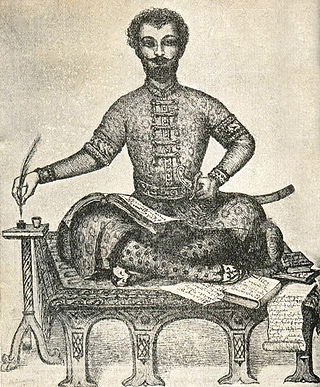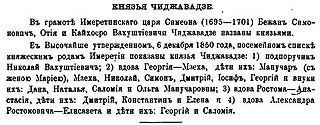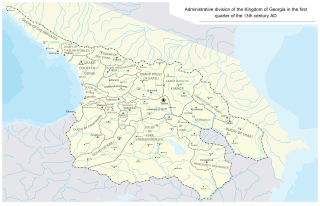
The Gandzieli family (literally meaning "of Gandza") was a noble family of Tavadi (Dukes) and later downgraded to the rank of Aznauri in the Kingdom of Georgia, in the period between 1083 and 1727.

The Gandzieli family (literally meaning "of Gandza") was a noble family of Tavadi (Dukes) and later downgraded to the rank of Aznauri in the Kingdom of Georgia, in the period between 1083 and 1727.
According to an extensive study of the surnames of Georgian nobility by Prince Vakhushti Bagrationi, Gandzieli's held the dukedom in Gandza, then Armenia currently part of Azerbaijan. Gandzielis lost their dominance over the Armenian duchy in 1727, as a consequence of the "lowering of the Kingdom of Armenia [1] " and moved to Principality of Ksani, Georgia. However, due to the failure to sustain power in Gandza, the Georgian monarch Vakhtang VI of Kartli lowered Gandzielis to the rank of Aznauri which was equal to that of Marquess [ citation needed ] at the time. In Ksani, Gandzielis assumed the title of the Royal Aznauri of Ksani, the highest of all the Aznauri degrees and led the court of the Principals of Ksani alongside other noble families. Gandzielis have been mentioned in the Treaty of Georgievsk as the Royal Aznauris of Ksani Principality alongside several other noble families. However, Gandzielis later moved to the Kingdom of Imereti where their surname changed to that of Gegelia. This occurred "due to the linguistic traditions" of the Imereti people as Bagrationi reported in his study. Eventually, one branch of the Gegelia family of Aznauris moved to the Kingdom of Odishi, the late Samegrelo, where they governed the marquisate [ citation needed ] of Martvili, Salkhino and Taleri until the Communist Red Army invasion of Georgia in 1921. Gegelias nowadays reside both in Imereti and Samegrelo regions of Georgia.

Vakhushti was a Georgian royal prince (batonishvili), geographer, historian and cartographer. His principal historical and geographic works, Description of the Kingdom of Georgia and the Geographical Atlas, were inscribed on UNESCO's Memory of the World Register in 2013.

Vakhtang IV, of the Bagrationi dynasty, was a king (mepe) of Georgia who reigned from 1433 to his death, associated to the throne of his father Alexander I from 1433 to the latter's abdication in 1442 and sharing the throne with his three brothers until his death.

The House of Abashidze is a Georgian family and a former princely house. Appearing in the 15th century, they achieved prominence in the Kingdom of Imereti in western Georgia in the late 17th century and branched out in the eastern Georgian kingdoms of Kakheti and Kartli as well as the then-Ottoman-held southwestern region of Adjara. After the Russian annexation of Georgian polities, the family was confirmed as Knyaz Abashidze by the Tsar’s decree of 1825.

The Bagrationi dynasty is a royal dynasty which reigned in Georgia from the Middle Ages until the early 19th century, being among the oldest extant Christian ruling dynasties in the world. In modern usage, the name of the dynasty is sometimes Hellenized and referred to as the Georgian Bagratids, also known in English as the Bagrations.

Bagrat III (1495-1565), of the Bagrationi dynasty, was a king (mepe) of Imereti from April 1, 1510, to 1565. He succeeded upon the death of his father, Alexander II, and faced repeated assaults from the Ottoman Turks as well as the conflicts with his ostensible vassal princes of Mingrelia, Guria, and Abkhazia who were frequently joining the enemy.
Giorgi III Gurieli, of the Georgian House of Gurieli, was Prince of Guria from 1669 to 1684 and King of Imereti from 1681 to 1683. He was energetically involved in civil wars in western Georgian polities, which he sought to bring under his sway. He was killed in battle while trying to recover the lost throne of Imereti.
George IV Gurieli, of the House of Gurieli, was Prince of Guria from 1711 to 1726, and a king of Imereti in western Georgia in 1716. He was installed as regent of Guria by his father, Mamia III Gurieli, then the king of Imereti, in 1712. In 1716, he seized the crown of Imereti, but was forced to abandon the enterprise later that year. Returning to Guria, his rule was challenged by a faction of local nobility, which included his mother Elene and brother Kaikhosro III Gurieli. He was finally able to crush the opposition after making peace with Bezhan Dadiani, Prince of Mingrelia.
The Battle of Sokhoista was fought between the Ottoman and Georgian armies at the Sokhoista field in what is now northeastern Turkey in 1545. It was the last attempt of the separate Georgian dynasts to fight as one unit against the Ottoman expansion, but ended in their decisive defeat. This might be the same battle as mentioned by Rüstem Pasha to have been fought at nearby Zivin.

The House of Chijavadze or Chizhavadze (ჩიჟავაძე) were a Georgian noble family (tavadi), prominent in the western Kingdom of Imereti in the 16th and 17th centuries.
Satavado, same as county, was a large feudal landholder and feudal hierarchy-political unit in the 15th-18th centuries in Georgia. Satavados were established in times of political and economical overthrow of Georgian Kingdom, by exploitation peasants and grooving immunity of feudal lords when they formed a new class of Tavadi (prince) / (duke). The Tavadi were one of the highest ranks of Georgian nobility, second only to the Royal Families of Georgia. The title of Tavadi is equivalent to the European titles of prince and duke. There are various ranks of princes in Georgian history. Other ranks include Mtavari and Eristavi
Kiknadze is a Noble Baronial and Chevalier family of the western Georgian Kingdom of Imereti. According to Prince Ioane of Georgia (1768–1830), Kiknadze's came from Rome. One of the Cicero's family members who accompanied Pompey on his Caucasian campaign in 65 BC. settled in Imereti. Baron Josiah-Cassius Kiknadze, conquered the land and The Ckheri Castle from prince Abashidze in upper Imereti and established Barony. Subsequently, this conquest was recognized and legitimized by the Kings of Imereti.
Bagrat (1741–1800) was a Georgian royal prince (batonishvili) of the Bagrationi dynasty of Imereti. He was the common ancestor of all male-line descendants of the kings of Imereti, surviving into the 21st century.
Simon was a Georgian royal prince (batonishvili) of the Bagrationi dynasty of Imereti.
Mamuka was a Georgian prince and the head of the Mukhrani branch of the royal Bagrationi dynasty of Kartli. He was Prince (batoni) of Mukhrani and ex officio commander of the Banner of Shida Kartli from c. 1730 and 1735. Having taken part in a rebellion against Nader Shah's Persia, Mamuka had to take refuge in the Russian Empire, where he pursued a military career. He was known as Mehmed Bek to the Persians and as Mamuka Davydov to the Russians.
Vakhushti Abashidze was a Georgian nobleman, prominent in the politics of the Kingdom of Kartli and one of the leaders of an insurrection against the Iranian hegemony in the 1740s.

Levan IV Dadiani was Prince of Mingrelia from 1681 until 1691, when he was forced to abdicate and retire to Constantinople, where he died. A natural son of the preceding Levan III Dadiani, he was the last of the First House of Dadiani to rule Mingrelia, a principality in western Georgia. The succeeding dynasty were the Chikovani, who assumed the surname of Dadiani and continued to rule Mingrelia until 1867.
Grigol Dadiani, of the House of Dadiani, was Prince of Mingrelia from 1788 to 1804, with intermissions from 1791 to 1794 and in 1802 when his position was filled by his rivaling brothers. His rule was marred by the long-standing struggle between the Imeretian crown seeking to subdue Mingrelia and Mingrelian efforts to win full independence, a continuation of the conflict which had plagued western Georgia for centuries. Grigol's rapprochement with the expanding Russian Empire resulted in Mingrelia becoming, in 1804, a Russian subject with a degree of internal autonomy under the Dadiani dynasty, an arrangement which remained in place until 1856.
Kakhaber II Gurieli, of the House of Gurieli, was eristavi ("duke") of Guria from c. 1469 until his death in 1483.

The Duchy of Tskhumi was a duchy (saeristavo) in a medieval Georgia. Ruled by a House of Shervashidze, the duchy existed from 8th to 14th century, in the north-western part of Georgia and comprised territories around modern Sukhumi, Georgia.

The collapse of the Georgian realm was a political and territorial fragmentation process that resulted in the dynastic triumvirate military conflict of the Bagrationi monarchs and war of succession in the united Kingdom of Georgia culminating during the second half of the 15th century.